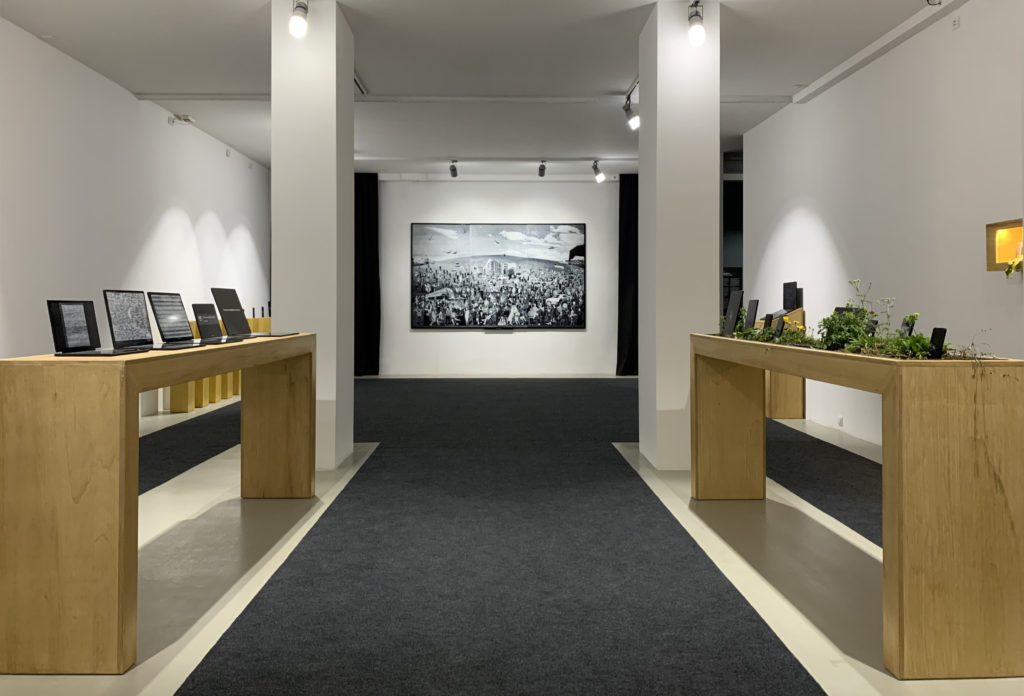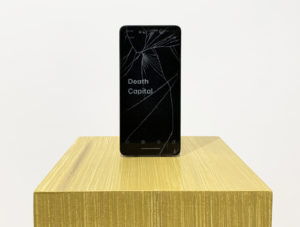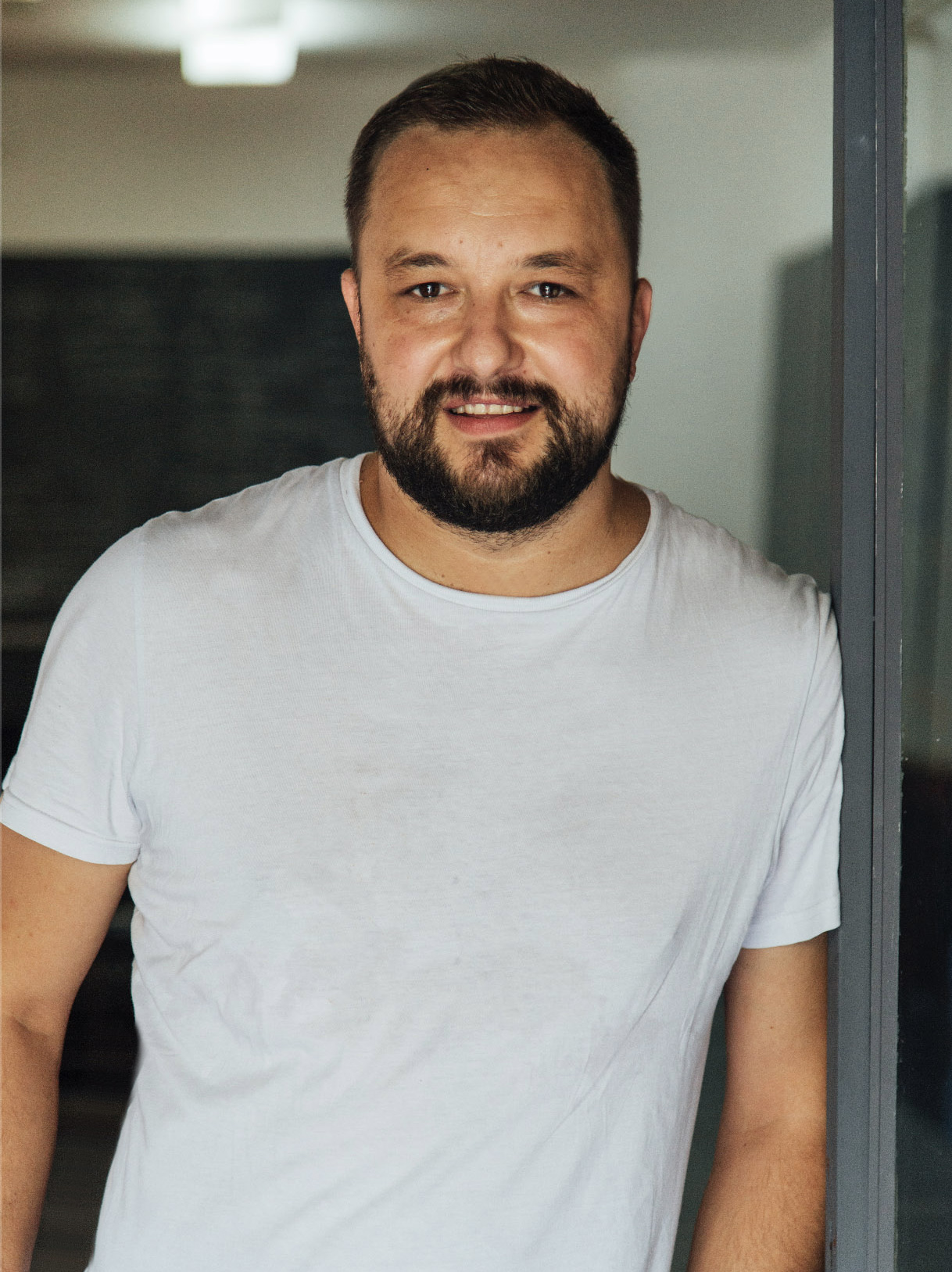Realtime Monument: Interview with Mladen Miljanović
Banja Luka-based artist Mladen Miljanović has had a long-standing interest in monuments and practices of remembering, from his The Garden of Delights (2013), an installation that emulates tombstone engravings created for the Bosnia and Herzegovina national pavilion at the 55th Venice Biennale, to his Draft for a 20 Minute Monument (2019), in which nine disabled men and war veterans sit for 20 minutes on a discarded pile of stones. This conversation, part of our Special Issue on Contemporary Approaches to Monuments in Central and Eastern Europe, was occasioned by his upcoming exhibition Realtime Monument at Budapest acb Gallery (March 10 – April 15, 2022). Previously shown at the Museum of Contemporary Art Belgrade (November 2021-January 2022), it addresses the intersection of monuments, commemoration, and representations of death in the age of a global pandemic.

Mladen Miljanović, Blaupunkt 20-21 installation view, courtesy of Museum of Contemporary Art Belgrade, 2022
Uroš Çvoro: Your work shows a long-standing interest in monuments. Previously, this interest was filtered through your personal history and first-hand experience in Bosnia and Herzegovina. This body of work seems to be moving towards a more universal, global plane. Can you talk about the motivation behind this exhibition?
Mladen Miljanović: Firstly, I think that here where I live, monuments are constantly and irresponsibly playing with us, so I find myself partly provoked to rethink my practice and to consider the role of monuments today! The second is the connection of my personal experience to the methodology and production of tombstones in the period that preceded my studies at the Banja Luka Art Academy. I was working in a small stonemason shop in the village where I grew up. This personal aspect manifests itself formally, as in The Garden of Delights. The third – the need to open a space of dialogue about what constitutes a monument and its significance in contemporary society – was provoked by the fact that monuments have become (obviously) a political and ideological element seeking to usurp the public sphere and the sphere of culture as something that manifests and perpetuates certain political ideas.
With this exhibition, I was interested in how to avoid or eliminate the time distance for creating monuments in the first place. This time distance is usually a significant element that increases the percentage of manipulation of history and real facts that are falsified. On the other hand, coincidentally or not, the COVID pandemic coincided with the beginning of my thinking about this topic, so I took 2020 and 2021 as a period of analysis about how death is communicated in the media, and the ways and forms through which the media represents death. As a counterpoint to this, I also offered the thesis of a possible post-apocalyptic vision of stone monuments to the media devices themselves, such as phones, tablets, laptops, and television sets. I use the stone-cutting engraving technique that I learned before enrolling at the Academy of Arts, not to immortalize the media image of death, but to highlight the media screen itself as a transmitter of that message.

Mladen Miljanović, Realtime Monument (2022), engraved drawing on granite, golden wreath 150×100 cm. Photo courtesy of Museum of Contemporary Art Belgrade.
UC: You propose the term “realtime monument” to describe the way in which this body of work commemorates death. Can you explain what you mean by this?
MM: This is exactly the title of one of the main works in this exhibition: Realtime Monument is experimenting in real time with creating a form that remembers a traumatic event that is still ongoing. Such a model eliminates forensics as a key factor in the post-festum model of monument creation. For this work, I took the daily data on the number of COVID deaths at the global level from the World Health Organization. That data download and creation of the monument in real time began on January 1, 2020, when China officiallyreported the first COVID death and one part was completed on August 1, 2021, as the first formal part of ongoing process. I downloaded and entered the global death numbers in the software that treats each number, i.e., each individual death as a point. After that, these points horizontally formed a set/saturation engraved on black stone. The aesthetic result is reminiscent of the noise or snow glitch that appears on the television screen when there is no program or when it is distorted; the dark waves represent the days and weeks in which most people died from COVID. In this work, the role of death and the current pandemic is consciously articulated and positioned as the most significant media and global event after the Second World War. On the other hand, during the entire period of 2020 and a large part of 2021 when we were in isolation and under quarantine, we were glued to the TVs in our living rooms and permanently bombarded with death reports. This ultimately initiated the decision to present this work as a stone TV with a gilded wreath that refers to the treatment of reality we live as a kind of thriller movie that, due to its global unpredictability, wins the award for best film. As a basis for understanding and observing reality as a form of movie or reality as a directed event, I quote the cult performer Tomislav Gotovac who says, “As soon as I open my eyes, I see a movie.” This statement places the observer and the act of watching as a position of participation in a politically and ideologically directed reality, in which watching is also testimony to the performative participation in that realistic event. So here, the pandemic is identified as an event in which we all participated, and where this work is a document and memorial to its victims.
UC: It is said that monuments have three temporalities: the historical moment they commemorate, the moment of their construction, and the moment of their reception. In this body of work, you are collapsing these three temporalities. What do you think is the effect of this?
MM: That’s right, I think that each of these temporalities is most often contaminated with time deviation. In this concept, the aim was not to destroy them, but to eliminate them completely. To achieve and justify the ambition of the thesis of Realtime Monument, it was first necessary to combine the elements of construction and reception. This meant that art is treated more as a field of documentation of a traumatic event that shows the form of its presentation even before the event is completed or ended. The best parallel to what I aspired to do is the principle of photography as a document in art, most often in documenting performances and happenings. These photographs were subsequently exhibited and presented not as works of art; they only suggest that art once happened somewhere. In my work, the ongoing happening is documented and that documentation – in the form of artworks – is exposed even before the pandemic/happening is over. With this method, the Realtime Monument work directly interferes with the very life of the event it deals with, so the audience at that moment is in the position of witnessing their own testimony. This concept is a step towards a much more radical idea that I’m still developing, and that is the possibility of the “preemptive monument.” This research is still in development and is based on the local-Balkan practice where people build their own monuments before they die.
I think that the moments of memorization and construction are very important and most often manipulated by political structures that are in power. Here in Bosnia and Herzegovina, the conflict that was ended by the Dayton Peace Agreement only silenced weapons but made Bosnia and Herzegovina parcelized by monuments. These small and mostly badly formed monuments acted as national territory markers. On the contrary, I think it would be important to permanently emphasize the idea of transforming the monuments of the past into a promising future. At this point, the monuments in Yugoslavia have the ability to formally transform this knowledge of the past into a discourse on the future. In doing so, I think that in Yugoslavia we have reached the point in which memorials become emancipatory places; today’s more pluralistic approaches to monuments are exemplary.

Mladen Miljanović, Blaupunkt 20-21, engraved drawing on black granite, 310 x 180 cm. Photo courtesy Museum of Contemporary Art Belgrade.
UC: The work Blaupunkt 20/21 thematically and aesthetically recalls your earlier work The Garden of Delights (2013). Can you tell us a bit more about the relationship of these two works?
MM: The Garden of Delights was as a concept created for the Bosnia and Herzegovina Pavilion at the 55th Venice Biennale. It had as its subject or field of research the regional space of the Balkans and the way of making realistically engraved representations on monuments. Blaupunkt 20/21 is a work that explores how death is communicated through the mass media on a global scale. It is made as a large-scale stone TV in nine sections, constructed of black granite onto which 261 figures and 20 objects are engraved. All the figures are people who passed away during 2020 and 2021; they are mostly well-known public figures whose deaths were communicated in images by the media. I asked friends to send me the names and photos of those who died from different countries, then these individual figure images were engraved using a hyperrealistic technique on the granite slabs. All these figures from around the world were compositioned into one meadow that is reminiscent of old Renaissance compositions. This work literally illustrates Marshall McLuhan’s phrase that the world is a “global village” in the age of the Internet, and to this I would add in the age of capitalism. On the other hand, I think we live in a very fragmented and divided world, and that art has to constantly offer different even utopic models for how to reconnect, socialize and integrate this fragmented world. So, in addition to the fact that this work is a tribute to all these people, it embodies the idea of inclusiveness, which is very important in most of my work. For example, it would be hard to think about a context in which Italian art theorist Germano Celant, a Serbian folk singer, and an Iranian LGBTQI+ rights activist could find themselves together. On the other hand, the whole exhibition Realtime Monument uses the local, hyperrealistic engraving technique. This work also elevates this native regional aesthetic to a universal level and places it within the social field where it is not often used. The installation Blaupunkt 20/21consists of elements that do not serve death and the end of life, but the infinite and immortal life that defines this technique. In this case, immortality comes from the fact that people who engrave their portraits and figures onto tombstones believe that the carved images allow them eternal existence.

Mladen Miljanović, Death Capital (2022), engraved text on stone object, 7×11 cm. Photo courtesy of Museum of Contemporary Art Belgrade.
UC: This exhibition heavily features screens: cracked screens, malfunctioning screens, screens with slogans (“Subscribe or Die,” “Death as pedestal,” “Postmortem new media”). What is the relationship between screen culture and monuments in the present?
MM: Just as statistics is an accurate set of inaccurate data, art should be an accurate set of representations of a deformed reality, in which art can and should try to play a corrective role. Thus, our accelerated reality with high-tech and advanced electronic devices, such as the laptops, mobile phones, and digital television sets used in this exhibition, are replicated and frozen in primitive forms of stone that ultimately act as postmortem new media. The engraved texts on the stone telephones are, in fact, the statements or suggestions on how to read this exhibition. The works Monument to the Victims of Monuments, Death is the Greatest Chance of Lifetime for Many, and Death as a Pedestal address the key issues that this exhibition deals with. There are also inscriptions such as Death-Capital, which point not only to the economy of death and profit from death, but also the tendency to radically petrify the overload of the distribution of reality through media devices today.
With this body of work, my intention is to ask questions as well as provoke certain answers to the question of what are the social, political and cultural media spaces of death. How many images of death remain engraved in the user’s memory, and how many are engraved in the devices themselves? The presented concept obviously reexamines the media language of death representation and how that language of charts and statistics identifies death with market goods and consumer products, such as rice or oil. All these different languages are perspectives from which we should question the role of monuments in the contemporary world we live. The entire ambient installation of these works seeks to explore representations or images of life that at one point become extensions of death, assuming that where life ends, the monument, the image, the representation continue to live.
This article is part of the Special Issue Contemporary Approaches to Monuments in Central and Eastern Europe. You can find links to the other articles in the special issue below:





